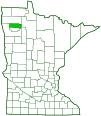four-speckled hover fly
(Dioprosopa clavata)
Conservation • Description • Habitat • Ecology • Distribution • Taxonomy
|
|
|||||||||||||
Description |
Four-speckled hover fly is a medium-sized, 5 ⁄16″ to ½″ long, syrphid fly. The female is slightly smaller than the male. The compound eyes are reddish-brown are bare, not hairy. On the male the eyes meet near the top of the face. On the female the eyes do not meet. The antennae are brownish and short. The thorax is black with no yellow spots. The plate between the thorax and the abdomen (scutellum) is black with yellow marks at the front and rear. The legs are yellow and black. The narrow first segment of the abdomen is black with a bluish iridescence. The second, third, and fourth segments are black with one yellow mark on each side. The tip of the abdomen is rounded in males, pointed in females. The wings are clear. |
Size |
Total length: 5 ⁄16″ to ½″ |
Similar Species |
Habitat |
|
Ecology |
Season |
|
Behavior |
|
Life Cycle |
|
Larva Hosts |
Aphids |
Adult Food |
Flower nectar and pollen; aphid honeydew |
Distribution |
||
|
Sources |
|
| 8/15/2025 | ||
Occurrence |
||
|
||
Taxonomy |
|
Order |
|
Suborder |
Brachycera |
Infraorder |
Cyclorrhapha |
Zoosection |
Aschiza |
Family |
Syrphidae (Hover Flies) |
Subfamily |
|
Tribe |
Syrphini |
Genus |
Dioprosopa |
Subordinate Taxa |
|
|
|
Synonyms |
|
Baccha babista Baccha clavata Baccha fusciventris Baccha varia Conops quadrimaculata Pseudodoros clavatus Spazigaster bacchoides Syrphus clavatus |
|
Common Names |
|
four-speckled hover fly |
|
Glossary
Scutellum
The exoskeletal plate covering the rearward (posterior) part of the middle segment of the thorax in some insects. In Coleoptera, Hemiptera, and Homoptera, the dorsal, often triangular plate behind the pronotum and between the bases of the front wings. In Diptera, the exoskeletal plate between the abdomen and the thorax.
Visitor Photos |
||
Share your photo of this insect. |
||
This button not working for you? |
||
|
||
|
||
MinnesotaSeasons.com Photos |
||
|
||
|
||

Slideshows |
|

Visitor Videos |
||
Share your video of this insect. |
||
This button not working for you? |
||
|
Other Videos |
||
Syrphid Fly - Larva, Emerging from Pupa, and Preparing to Fly (male Dioprosopa clavata) |
About
Published on Oct 7, 2017 This Syrphid Fly (AKA Hover or Flower Fly) is beneficial in both the larval and adult stages. Larvae voraciously feed on Aphids; adults are native pollinators. Larvae are found in Aphid colonies, so using any type of pesticide on Aphids will also destroy their natural predators and decrease the population of native pollinators. The larva in this video had stopped feeding and then released a gooey black blob in advance of pupating. (I don't understand its reaction to the black blob.) It took around 3 hours after emergence to prepare for flight. Note the fluid moving in the abdomen and the close view of its proboscis (feeding tube). This beautiful male was released in my garden. Guest appearance by a Leafhopper. Filmed with a digital microscope and a Sony AX100 from September 29 - October 7, 2017 in the Missouri Ozarks, USA. Flies (Diptera) » "Aschiza" » Syrphid Flies (Syrphidae) » Syrphinae » Syrphini » Dioprosopa » Dioprosopa clavata - MALE Music: Canon in D Major by Kevin MacLeod is licensed under a Creative Commons Attribution license (https://creativecommons.org/licenses/by/4.0/) |

Visitor Sightings |
||
Report a sighting of this insect. |
||
This button not working for you? |
||
|
|
MinnesotaSeasons.com Sightings |
||
|

Created: 10/1/2014 Last Updated: © MinnesotaSeasons.com. All rights reserved. |
